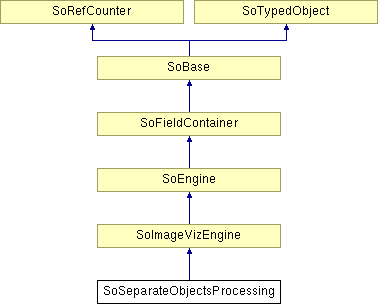SoSeparateObjectsProcessing Class Reference
[Separating And Filling]
 SoSeparateObjectsProcessing engine separates objects in a binary image.
More...
SoSeparateObjectsProcessing engine separates objects in a binary image.
More...
#include <ImageViz/Engines/ImageSegmentation/SeparatingAndFilling/SoSeparateObjectsProcessing.h>

Public Types | |
| enum | SeparationMode { SEPARATED_OBJECTS = 0, WATERSHED_RIDGES = 1, SEPARATED_BASINS = 2, CONTIGUOUS_BASINS = 3, CONTIGUOUS_OBJECTS = 4 } |
| enum | AlgorithmMode { REPEATABLE = 0, FAST = 1 } |
Public Member Functions | |
| SoSeparateObjectsProcessing () | |
Public Attributes | |
| SoSFEnum | computeMode |
| SoSFEnum | neighborhood3d |
| SoSFImageDataAdapter | inBinaryImage |
| SoSFEnum | separationMode |
| SoSFEnum | algorithmMode |
| SoSFInt32 | contrastValue |
| SoImageVizEngineOutput < SoSFImageDataAdapter, SoImageDataAdapter * > | outSeparationImage |
Detailed Description
 SoSeparateObjectsProcessing engine separates objects in a binary image.
SoSeparateObjectsProcessing engine separates objects in a binary image.
This engine computes the watershed lines of a binary image. You can adjust the contrast level which is used to reduce the number of markers for the watershed process.
This engine is a high-level combination of watershed, distance transform and numerical reconstruction algorithms. There is a limitation to the separating ability: if some particles overlap too much, they will not be separated. This engine can be used on the gradient modulus to compute best-fit contours.
Notice: This engine requires to preliminarily load the whole input data set into memory to be computed. As a consequence the input data set will be automatically loaded before the execution of this engine, ignoring the maximum memory parameter of the SbImageDataAdapterHelper::getAppropriateAdapter function or SoFileDataAdapter class If the input data set cannot fit in memory, this engine will fail during its computation. |
SEE ALSO
SoHExtremaWatershedProcessing.
FILE FORMAT/DEFAULT
- SeparateObjectsProcessing {
| computeMode | MODE_AUTO |
| neighborhood3d | CONNECTIVITY_26 |
| inBinaryImage | NULL |
| separationMode | SEPARATED_OBJECTS |
| algorithmMode | REPEATABLE |
| contrastValue | 4 |
Library references: binseparate
- See related examples:
Member Enumeration Documentation
- Enumerator:
Constructor & Destructor Documentation
| SoSeparateObjectsProcessing::SoSeparateObjectsProcessing | ( | ) |
Constructor.
Member Data Documentation
Select the algorithm mode for fastwatershed.
Use enum AlgorithmMode. Default is REPEATABLE
Select the compute Mode (2D or 3D or AUTO) Use enum ComputeMode.
Default is MODE_AUTO
The depth of valley.
Default value is 4.
The input binary image.
Default value is NULL. Supported types include: binary color image.
In 3D configuration (see computeMode), the neighborhood connectivity defines the connectivity considered for processing adjacent voxels.
Use enum Neighborhood3d. Default is CONNECTIVITY_26.
| SoImageVizEngineOutput<SoSFImageDataAdapter,SoImageDataAdapter*> SoSeparateObjectsProcessing::outSeparationImage |
The output separation (binary or label) image.
Default value is NULL. Supported types include: grayscale binary label color image.
Select the output image type: separation lines, split objects, separated basins or joined basins.
Use enum SeparationMode. Default is SEPARATED_OBJECTS
The documentation for this class was generated from the following file:
- ImageViz/Engines/ImageSegmentation/SeparatingAndFilling/SoSeparateObjectsProcessing.h